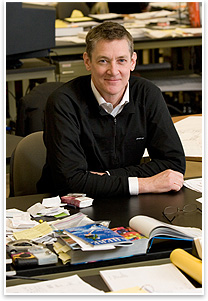
 James Timberlake, FAIA James Timberlake, FAIA
Summary: James Timberlake, FAIA, is a founding partner of Kieran Timberlake Associates LLP, based in Philadelphia. He is an adjunct professor at the University of Pennsylvania School of Design and Endowed Professor in Sustainability at the University of Washington College of Architecture and Urban Planning. Timberlake has served as the Eero Saarinen Distinguished Professor of Design at Yale University, Max Fisher Chair at the University of Michigan, and has taught at Princeton University, the University of Texas at Austin, and other institutions. He has co-authored two books: Manual, The Architecture of KieranTimberlake, and refabricating Architecture. Timberlake’s forthcoming book, Loblolly House: Elements of a New Architecture, (written with Stephan Kieran, FAIA) is a case study of their award-winning residential project. Kieran Timberlake is the recipient of the 2008 AIA Firm Award. Education How would you describe your firm’s work? Favorite project When and why did research become a cornerstone of Kieran Timberlake’s design methodology? At that particular point, we embedded research as a principal piece of our process in what we do, so it now informs and is involved in every aspect of the firm’s work—whether we write books, do buildings, talk and lecture, or teach. Receiving that award was an enabler that allowed Steve and me to create full-time permanent research positions within our office that are now led by a director of research, and by the end of the year will involve 4-6 full-time people. How do you integrate their research into your practice? KTA was interested in sustainable design before LEED®. Where did that interest originate? Some of the first projects that we attempted to do this on go back to the mid-early 1990s, such as the Shipley School in Bryn Mawr, Pa. In that project, we tried to assemble a palette of materials that, at that particular time, would have been thought of as pretty highly sustainable material products, including cork flooring, slate walls, and engineered wood products. We call it an environmental ethic, and that environmental ethic has been deeply embedded in our design processes well before LEED. I think we try to do projects when clients come to us such as Middlebury College, and say: “Look, we’re interested in environmentally ethical project, but we don’t necessarily want to follow the LEED practices.” I think we’re comfortable with that, because we realize we can take a building deep in the sustainable realms without necessarily having a checklist to tick off. That’s where we would hope that the profession gets. We appreciate that the U.S. Green Building Council has been very kind and gracious to us, and we’ve been very supportive of in turn. There needs to be a mechanism such as LEED in order to bring the profession along, but I think we would hope—as does the USGBC—that these processes become so deeply engrained in architects’ practices that eventually we don’t have to necessarily have a checklist to do this. But architects need to be retrained, and that’s one way of getting retrained. What’s happening with the Make It Right project in New Orleans? We personally have contributed financially beyond our time. We’ve contributed a significant sum of money through our lecturing to Make It Right, and we would hope that architects would also help contribute financially to building a home through one of the prototypes that they find interesting. They can contribute directly to one of those prototypes and enhance the accessibility of that particular prototype to one of the families in New Orleans so that more of these houses can get built. On receiving the AIA Firm Award What are you reading? Sources of inspiration To bring this full circle, the reason I brought up the book is that in the end, what’s inspired us recently has really been these moments such as Katrina and the plight of some of the individuals in the Ninth Ward, and that’s one of the reasons why we’ve contributed as we have to Make It Right. In the case of India and Bangladesh, four days in India in Ahmedabad and four days in Dhaka have really transformed our thinking about how architecture can be useful and be seen as transformative to the lives of others. Talking for a couple of hours with individuals in Dhaka who need housing can really change one’s outlook on life and what this profession can offer. Although I can’t name one individual, I have to say that the panoply in the library—in the pantheon of those individuals who have inspired us—I think right now our inspiration is Mrs. Rogers in New Orleans who took the time to investigate our house and has selected our house as the one that she wants to live in because it meets her needs. I think we learn from that. |
||
Copyright 2008 The American Institute of Architects. All rights reserved. Home Page |
||
news headlines
we the people
business
members connecting
Recent Related
› KieranTimberlake Designs Expandable Home and Flexible Townhome
› Accent on Architecture Gala Honors the Best and Brightest
› Happy Earth Day: COTE Top Ten Green Buildings
For more information on Kieran Timberlake’s research and design, visit their Web site.
